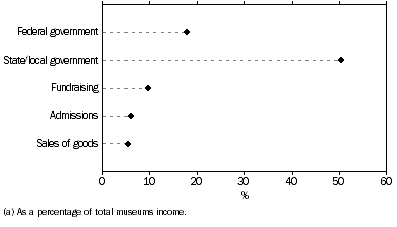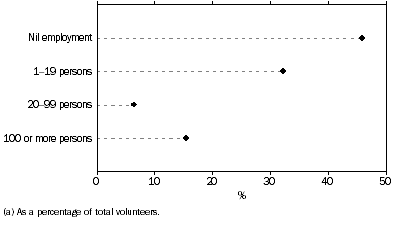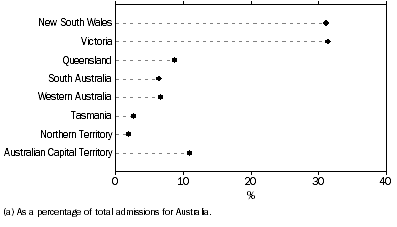INTRODUCTION
This publication presents results from an Australian Bureau of Statistics (ABS) survey of organisations engaged in operating museums and art galleries. The survey was conducted in respect of the 2003-04 financial year. This is the fourth ABS survey of museums and art galleries. Previous collections were conducted in respect of 1999-2000, 1997-98 and 1996-97 financial years.
COMPARISONS WITH PREVIOUS SURVEY RESULTS
Historical comparisons are not made for museums/art galleries due to significant changes in scope since the conduct of the last survey in respect of 1999-2000.
MORE INFORMATION ON ABS SERVICE INDUSTRIES STATISTICS
Information about ABS activities in the field of service industries statistics is available from the Service Industries Statistics theme page.
COMMENTS
The ABS welcomes comments and suggestions from users regarding future surveys of Service Industries. These comments should be addressed to the Director, Service Industries Business Statistics Centre, Australian Bureau of Statistics, GPO Box 2796Y, Melbourne, Vic. 3001.
ROUNDING
Where figures have been rounded, discrepancies may occur between the sum of component items and the total.
INQUIRIES
For further information about these and related statistics, contact the National Information and Referral Service on 1300 135 070 or William Milne on Melbourne (03) 9615 7862.
MAIN FEATURES
INTRODUCTION
This publication presents results of the 2003-04 Museums Survey. This survey is conducted periodically by the ABS to provide detailed measures of the performance, structure and activity of museums and art galleries operating in Australia. It includes aspects such as: the composition of income and funding received; details of expenses incurred; characteristics of employment; and activities of museums and art galleries. A state dimension is also presented.
The scope of the 2003-04 Museums Survey was organisations that were engaged in the operation of museums and art galleries. These operations included the display, storage and preservation of museum objects and artworks. Museums and art galleries were only included if they were open to the general public during the 2003-04 reference year.
Further information on the scope can be found in paragraphs 2-4 of the Explanatory Notes.
For ease of reading, museums and art galleries are referred to collectively as museums.
SUMMARY OF FINDINGS
At the end of June 2004, there were 1,329 museum locations operating in Australia, comprising: 160 art museums/galleries, 381 historic properties/sites, 673 social history museums, and 116 other types of museums.
During 2003-04, there were 31.2 million admissions to Australia's museums. Free admissions accounted for 66.1% of all admissions, while paid admissions accounted for 33.9%. Income from paid admissions was $55.9m.
At the end of June 2004, these museums employed a total of 7,624 persons. Social history museums had the largest proportion of total employment (31.9% or 2,434 persons), followed by art museums/galleries (27.3% or 2,081 persons) and historic properties/sites (17% or 1,298 persons).
During 2003-04, museums received $919.4m in income and incurred $810.3m in expenses.
Just under three quarters (73.5%) of museums had a web presence at the end of June 2004.
MUSEUM OBJECTS AND ARTWORKS
At the end of June 2004, there were 54.9 million museum objects and artworks located in Australia's museums, however only 9.7% (5.3 million) were on display for public viewing.
Museums with larger employment had fewer objects or artworks, from their collection, on display to the public. Museums with employment of 20 or more persons held the largest proportion of museum objects and artworks (84% or 46.2 million), but only displayed 2.9% (1.3 million) of their collection to the public.
During 2003-04 there were 224,032 new acquisitions of museum objects and artworks, with the majority (73.8% or 165,417) acquired through donations.
For the same period, donations and bequests of artworks totalled 13,484 items and were valued at $45.6m.
At the end of June 2004, the majority (68.8%) of museum objects and artworks were documented or recorded in manual/written form, while 38.8% were documented or recorded in electronic form or on computer. Museum objects and artworks could be documented/recorded in both forms.
INCOME
During 2003-04 museums received a total of $919.4m in income. Most (68.3% or $628m) of this income was sourced from government funding. The graph below shows that 50.4% ($463.5m) came from state and local government, while 17.9% ($164.5m) came from federal government.
Other sources of income included: fundraising (9.7% or $89m), admissions (6.1% or $55.9m) and sales of goods (5.4% or $50.1m).
SELECTED SOURCES OF INCOME(a)

Funding for projects that were deemed one-off comprised 12.3% ($77.5m) of all government funding. Donations and bequests accounted for 70.8% ($63m) of all fundraising income.
EMPLOYMENT AND VOLUNTEERS
At the end of June 2004 there were 7,624 persons employed in museums, comprising 4,291 (56.3% ) full-time employees and 3,252 (42.7%) part-time employees. There were also 81 (1.1%) working proprietors and partners.
Managers, administrators and clerical support workers accounted for 30.3% (2,310 persons) of all employed persons. Museum or gallery attendants accounted for 22.7% (1,730 persons) and curators 13.5% (1,029 persons).
Museums employing 100 or more persons accounted for the majority (60.6% or 4,619 persons) of total employment. Museums with 1-19 persons employed accounted for 27.6% (2,104 persons), while museums with 20-99 persons employed accounted for 11.8% (901 persons).
Museums had large numbers of volunteers (20,443 people) assisting with their operations during June 2004, working a total of 343,139 hours. This represented an average of 16.8 hours over the month for each volunteer.
Over half (56.1% or 11,468 persons) of these volunteers assisted as museum or gallery attendants and security officers. A further 22.4% (4,577 persons) of volunteers assisted as managers, administrators and clerical support workers.
The following graph shows that volunteers were more prevalent in museums with nil or low employment. Museums with nil employment accounted for 45.9% (9,382 persons) of all volunteers, while museums employing 1-19 persons accounted for 32.2% (6,587 persons).
VOLUNTEERS BY EMPLOYMENT SIZE(a)

EXPENDITURE
During 2003-04, museums incurred expenses of $810.3m. The main contributor to total expenses for employing museums was labour costs at $320.4m (39.5%). The major component of labour costs was wages and salaries ($277.1m) which represented an average of $36,700 per employee.
Other major expenses were: depreciation and amortisation at $98.8m (12.2%), exhibition/display development costs at $32.3m (4%) and purchases at $27.2m (3.4%).
STATES AND TERRITORIES
The majority of museums were located in the three most populous states; New South Wales accounted for 31.1% (413) of all locations, Victoria, 21.5% (286) and Queensland, 17.5% (232).
However, while New South Wales and Victoria also had the highest proportions of employment (33.3% and 26.4% respectively), the Australian Capital Territory had the third highest proportion of the employment total at 13%.
The graph overleaf shows that at the end of June 2004, Victoria and New South Wales had similar proportions of admissions to museums (31.4% or 9.8 million and 31.1% or 9.7 million respectively). The Australian Capital Territory had the next highest proportion (10.9% or 3.4 million).
ADMISSIONS TO MUSEUMS BY STATE(a)

The graph below shows that the Australian Capital Territory, South Australia and the Northern Territory had more free admissions than paid admissions within their respective states/territories ( 83.9%, 77.9% and 68.7% respectively).
PAID AND FREE ADMISSIONS BY STATE(a)

Victoria had the highest proportion of museum objects/artworks (37.7%) followed by New South Wales (30.4%).
SUMMARY OF OPERATIONS BY TYPE OF MUSEUM |
|  |
 |  |  | Art museums/ galleries | Historic properties/ sites | Social history museums | Other museums | Total |  |
|  |
| Museum/gallery locations at end June | no. | ^160 | 381 | 673 | ^116 | 1,329 |  |
| Employment at end June | no. | 2,081 | 1,298 | 2,434 | 1,811 | 7,624 |  |
| Volunteers during the month of June | no. | ^3,125 | ^4,814 | ^11,185 | ^1,318 | 20,443 |  |
| Income |  |  |  |  |  |  |  |
 | Government funding(a) | $m | 200.4 | 47.9 | 193.0 | 186.7 | 628.0 |  |
 | Admissions | $m | 8.8 | 18.1 | ^20.2 | 8.9 | 55.9 |  |
 | Fundraising | $m | 62.0 | 6.8 | 12.5 | 7.7 | 89.0 |  |
 | Other | $m | 53.7 | 24.6 | 33.7 | ^34.3 | 146.5 |  |
 | Total | $m | 324.9 | 97.5 | 259.4 | 237.6 | 919.4 |  |
| Expenses |  |  |  |  |  |  |  |
 | Labour costs | $m | 99.1 | 39.6 | 91.5 | 90.1 | 320.4 |  |
 | Other | $m | 166.4 | 41.0 | 138.3 | 144.2 | 489.9 |  |
 | Total | $m | 265.5 | 80.6 | 229.7 | 234.4 | 810.3 |  |
| Purchases of museum objects/artworks(b)(c) | $m | 28.7 | 0.5 | ^4.3 | 1.1 | 34.6 |  |
| Admissions(c) |  |  |  |  |  |  |  |
 | Paid | '000 | ^1,546.3 | ^2,798.9 | ^4,025.5 | 2,188.9 | 10,559.5 |  |
 | Free | '000 | *9,934.6 | *1,988.3 | 5,801.0 | *2,906.7 | ^20,630.6 |  |
 | Total | '000 | *11,480.9 | ^4,787.1 | 9,826.5 | ^5,095.6 | ^31,190.1 |  |
| Museum objects/artworks at end June | '000 | *2,915.5 | 1,609.8 | 10,057.2 | 40,333.0 | 54,915.5 |  |
| Special exhibitions held(c) | no. | ^1,612 | *279 | ^1,346 | *168 | 3,405 |  |
|  |
| ^ estimate has a relative standard error of 10% to less than 25% and should be used with caution |
| * estimate has a relative standard error of 25% to 50% and should be used with caution |
| (a) Includes current and capital funding and funding for one-off projects. |
| (b) Includes current and capital expenditure. |
| (c) During year ended 30 June. |
 Print Page
Print Page
 Print All
Print All